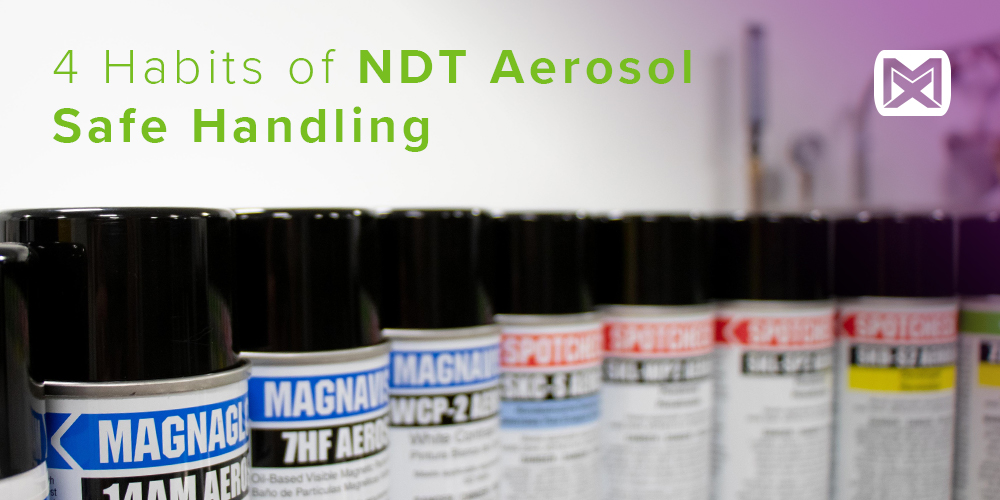
Hazards
Safety must be top priority when working with an aerosol can. Whether aerosols are used in an indoor setting or outside, such as an oil pipeline, the safe handling of aerosol should be considered. There are three main hazards when working with aerosol cans.
- Aerosol pressurization: If the can and valve remain intact, aerosol cans remain safe. However, if a can is punctured, the valve fails, corrodes, or is exposed to excessive temperatures, the can will depressurize. In severe cases, the aerosol may even explode.
- Safety Data Sheet (SDS): Do you know what is in your aerosol can? Many aerosols contain hazardous substances, and workers must be familiar with the SDS for the material. Personal protective equipment or additional ventilation may be required. SDS’s are often found on manufacturer websites; review the hazards, and select the safest product.
- Flammable Propellents: Many products and propellants are flammable, which causes an aerosol to be a fire hazard. Have you considered where the aerosols are sprayed? Is there an open flame source nearby?
Aerosol Can Storage
Aerosol cans should always be stored in dry areas where they will not be exposed to excessive temperatures. As the temperature increases, the pressure in the can will also increase. Car or truck interiors can become very hot in the sunlight; therefore vehicles are generally not a safe location for storage.
Aerosol cans should be kept in a flammable liquid cabinet. Under the Occupational Safety and Health Administration’s (OSHA) standard for flammable liquids, must be kept in a fire-resistant storage cabinet or inside storage room rated for fire resistance. Approved storage cabinets include built-in grounding connectors, vents to maintain safe temperatures, and spill-proof door sills.
Aerosol Can Recycling
Aerosol cans that are empty of both propellant and product have the potential to not be considered hazardous waste and may be recyclable depending on the aerosol ingredients and local waste regulations. In the US according to the Resource Conservation and Recovery Act (RCRA), depressurized and empty aerosol cans are not considered hazardous waste if they do not contain any toxic or listed chemicals. Most aerosol cans that are made of steel or aluminum can be recycled, but only if the can is empty. If the can is not empty, then it must be treated as a hazardous waste according to local waste regulations. It makes sense to puncture aerosol cans for sustainability and disposal costs, but puncturing an empty can with a sharp object such as a screwdriver could create a potential ignition source from frictional heat and static electricity. The screwdriver generates frictional heat against the can’s steel or aluminum body, which could result in a spark, which is why properly grounded, spark-resistant tools should be used to puncture an empty aerosol can. Review your local and/or national hazardous waste regulations to determine if the empty aerosol cans may be recycled.
Aerosol Can Shipping
When shipping hazardous materials, the shipping employee MUST be HazMat Certified. Aerosols cannot be shipped by air or ocean freight from any facility unless the shipping employee has the proper Certificate of Training Completion. For air freight, the training must be completed every two years. For ocean freight, the training must be completed every three years.
When shipping aerosols by ground freight, the employee MUST complete the DOT Code of Federal Regulations Training found in the 49CFR (DOT & Hazardous Material Transportation Training Program) parts 100-185. This training must be completed within 90 days after employment or a change in job function. Recurrent training should be completed every three years. Until an employee is trained, they may perform their job function under the direct supervision of a properly trained and knowledgeable hazmat certified employee. The employer is responsible for ensuring that each hazmat employee is trained and certified in accordance with the training requirements.
|
Shipping Mode
|
UN Number
|
Proper Shipping Name and Class
|
|
Ground
|
N/A
|
Consumables, Limited Quantity
|
|
Air
|
UN 1950
|
Aerosols, Flammable, 2.1
Note: Aerosols do not have a packing group associated with UN1950
|
|
Ocean
|
UN 1950
|
Aerosols, 2.1 (Limited Quantity)
Note: Domestic to Forwarder is the same as Ground Shipping
|
UN numbers or UN IDs are four-digit numbers that identify dangerous goods, hazardous substances and articles (such as explosives, flammable liquids, toxic substances, etc.) in the framework of international transport. They are assigned by the United Nations Committee of Experts on the Transport of Dangerous Goods.
As stated above, anyone that is not certified in shipping hazardous materials, should not ship via Air or Ocean. You must be HazMat Certified or you may get fined!
Published July 23, 2019